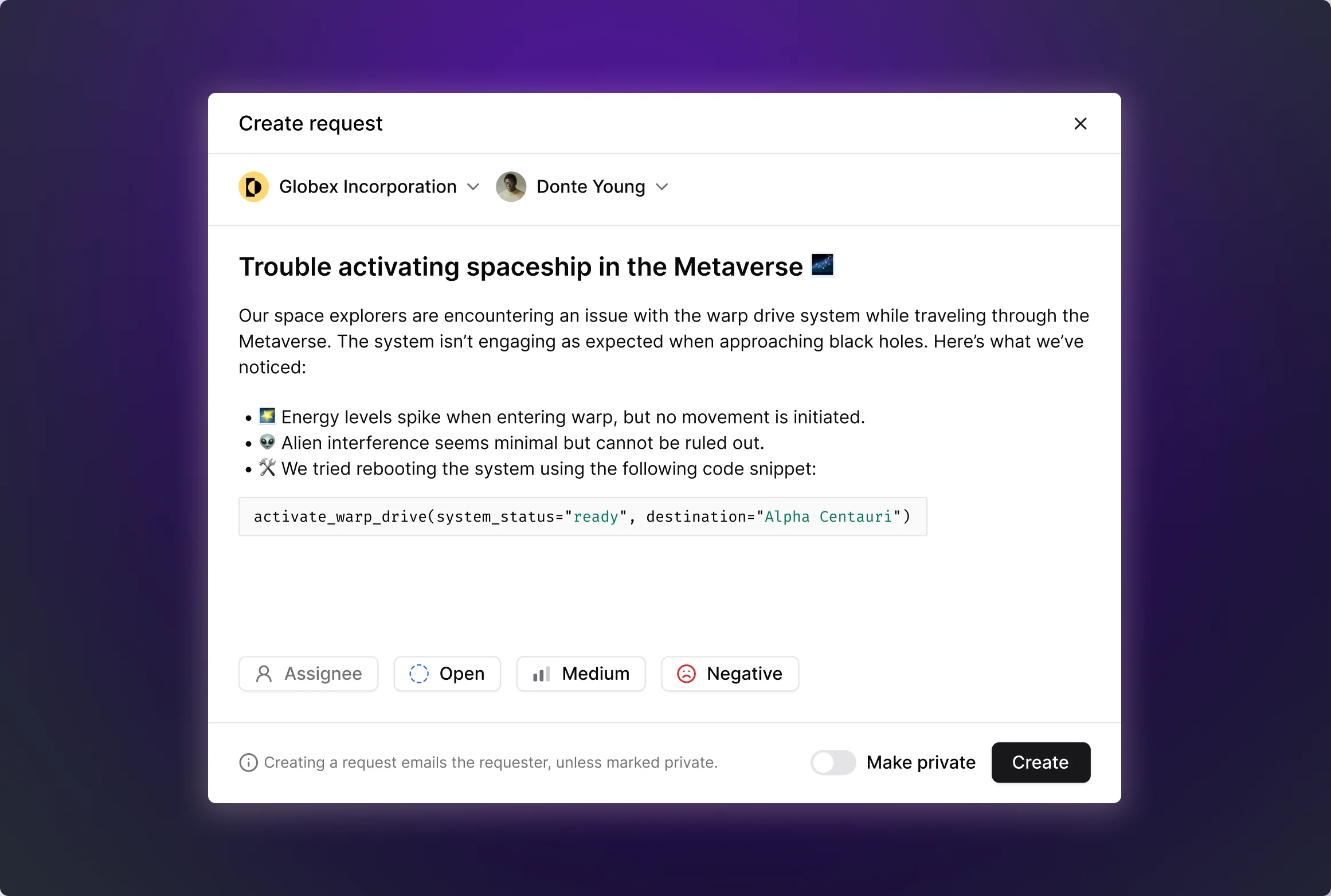Requests
Create requests from messages on Slack, web, email, and Microsoft Teams.
You’re viewing documentation for a previous version of Thena. For the most up-to-date content, visit: docs.thena.ai.

Overview
In Thena, a "Request" is the core unit that captures conversations and holds essential data for managing ticketing processes.
- 💬 Conversation
- ✉️ Private message
- 🔄 Status
- 👤 Assignee
- ⏰ Urgency
- 💧Source
- ⏳SLAs
- 📊 CRM account data
- 🔗 Linked integrations (e.g., Linear, Jira)
- 🔍 Recent related requests
- 🗂️ Request activity history
Explore requests
Requests can be configured to automatically route to pre-set Slack channels with a command center of actions.
The drawer consolidates all key elements of a request. Additionally, it allows seamless responses from Thena directly into the customer’s preferred communication channel.
Data analysis includes metrics like the number of requests per account, time to close, response time, and trends over specific periods filtered by assignee or account owner.
Request creation types
| Platform | Type | Source | Trigger |
|---|---|---|---|
| Thena AI | Automatic | Customer | Message in Slack channels |
| Slack tag | Manual | Customer, Vendor | @tag |
| Slack command | Manual | Vendor | /Create request |
| Slack action | Manual | Customer, Vendor | Create request |
| Slack emoji | Manual | Customer, Vendor | Add emoji 🎫 to any message in Slack |
| Microsoft Teams | Automatic | Customer | Message in MS Teams |
| Automatic | Customer | Email reaches the configured email address | |
| Web chat | Automatic | Customer | Message in web chat |
| API | Automatic | Customer, Vendor | Programmatic action |
Platform abilities
| Ability | Description |
|---|---|
| Thena AI | Thena AI processes requests in two modes: Aggressive and Conservative. Aggressive mode captures more requests but may increase false positives, while Conservative mode is more selective and minimizes errors. |
| Inspect | Use the "Inspect Customer Message" action in a Thena-integrated Slack channel to verify if a customer message triggered a request. The modal shows the request status, links, recent actions, or reasons why a request wasn’t created (e.g., conversation grouping, vendor message, AI misclassification). |
| Discard request | If a request is non-customer-related (e.g., rescheduling), discard it from the request drawer or triage channel. Discarded requests are permanently removed from workflows and analytics. |
| Triage block | Requests landing in the Triage channel in Slack include a block with actions like changing the assignee, status, custom fields, and adding external links. |
| Private request | When creating a request manually, you can mark it private, visible only to you and your org. The customer won’t be notified or see it on the portal. You can track it by status, urgency, and use the drawer for internal comments and activity tracking. |
| Email notification | For non-private manual requests, the customer will receive an email notification and can respond. Replies will sync bi-directionally between email and Thena. The default email will be requests@{yourworkspacename}.thena.email, customizable with DNS setup. |
Configuration
Head over to Settings to configure request settings.
| Feature | Description |
|---|---|
| Triage channel | Set up a triage channel for global or account-level requests. Choose an existing Slack channel or create a new one within Thena. |
| Delete triage notification | Automatically delete triage notifications after a specified number of days. |
| Emoji automations | Configure emoji-based workflows: Use an emoji like 👀 to assign the request and ✅ to close it. |
| Customer thread update | Automatically notify customers when a request is assigned to them. |
| Show preview from messages in private channels | For private channels, enable AI to reveal customer messages as previews in triage channels. |
| Conversation grouping window (mins) | Group messages from the same customer into one request within a set time (default: 2 minutes). |
| Auto close requests (days) | Automatically close requests marked In progress after a set number of days. |
| Host email domain | Slack guest channels can’t detect external organizations. Explicitly specify the host domain to manage this. |
| AI strategy for request detection | Choose an AI strategy for detecting requests: Aggressive generates more, while conservative creates fewer. |
| Exclude AI tags | Blacklist irrelevant AI tags to avoid unnecessary tagging. |
| Allow detection on discarded threads | If a request is discarded, enable AI to detect requests in subsequent replies within the same thread. |
| Auto-assign | Enable auto-assignment of requests to the first responder or account owner. |
| Send notification to assigned user | Automatically notify the assigned user when a request is assigned. |
Updated 5 months ago
